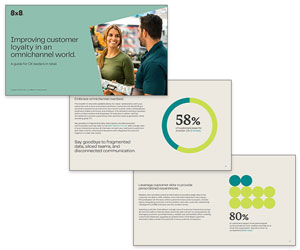Tricia Morris at 8×8 provides fifteen statistics that forecast the future of the contact centre.
Is the contact centre the next big tech frontier? With the move to the cloud and increased innovation forced upon many companies by the pandemic, it certainly appears so.
According to a report published by Allied Market Research (AMR), the global Contact Centre as a Service (CCaaS) industry is forecast to reach $19.8 billion by 2031, up from $4.3 billion in 2021.
But that’s not the only technology that will see a boost from the need and desire for accelerated innovation, as shown by these striking statistics that forecast the future of the contact centre.
The top challenges contact centre and customer experience (CX) leaders are facing today (and that they believe will remain the top challenges through 2030) are recruiting and retaining talent (53%) and reducing operating costs (40%). (Source: 8×8)
- The top challenges contact centre and customer experience (CX) leaders are facing today (and that they believe will remain the top challenges through 2030) are recruiting and retaining talent (53%) and reducing operating costs (40%). (Source: 8×8)
- Eighty-five percent (85%) of customer service agents want to work full-time at home and not return to contact centre offices. (Source: ASAAP)
- Sixty-eight percent (68%) of contact centre and CX leaders say their current technology solutions are not effective or are only somewhat effective in supporting digital transformation and the future of work. (Source: 8×8)
- Fifty-four percent (54%) of contact centre and customer experience leaders believe that cloud communications is the technology that will have the greatest near-term impact on customer service and engagement, followed by automation, machine learning, and data and analytics. (Source: 8×8)
- Twenty-one percent (21%) of CFOs plan to increase customer service spending and 72% to maintain spending through September 2023, despite economic pressures. (Source: Gartner)
- Approximately one-fifth (21.5%) of digital leaders are focused on creating a cohesive customer journey across all channels and devices to deliver seamless digital experiences that support long-term brand loyalty. (Source: Qualtrics)
- More than half (59%) of customer service and support leaders plan to devote more resources to improving, automating or eliminating inefficient processes in the near future. (Source: Gartner)
- Half of customer service and support leaders (51%) plan to devote more resources to migrating service volume to digital and self-service channels.
“In tough economic times, customer service and support leaders are often encouraged by their CFOs to make do with what they have,” says Jonathan Schmidt, Sr. Principal, Advisory in the Gartner Customer Service and Support practice.
“Given how difficult it is to hire and retain talent, it makes sense that they are tackling inefficiencies and prioritizing digital channels as a strategy for driving down costs without reducing headcount or sacrificing customer experience.” (Source: Gartner)
- 91% of contact centre leaders report that automation is a critical or important priority in the next year. (Source: Replicant)
- Nine out of ten agents want to see more aspects of customer interactions automated, including conversation summarization and disposition notes, knowledge searches, address changes, and bill payment. (Source: ASAAP)
- 84% of customer service and service support leaders cite customer data and analytics as “very or extremely important” for achieving their organizational goals in 2023. (Source: Gartner)
- Gartner predicts conversational AI will reduce contact centre agent labor costs by $80 billion in 2026.
“Gartner estimates that there are approximately 17 million contact centre agents worldwide today,” said Daniel O’Connell, Research Vice President at Gartner.
“Many organizations are challenged by agent staff shortages and the need to curtail labor expenses, which can represent up to 95% of contact centre costs. Conversational AI makes agents more efficient and effective, while also improving the customer experience.” (Source: Gartner)
- Gartner projects that one in 10 agent interactions will be automated by 2026, an increase from an estimated 1.6% of interactions today that are automated using AI. (Source: Gartner)
- More than three-fourths (76%) of contact centres currently leverage some type of chatbot technology. Among the 19% who don’t, 31% say their contact centres plan to implement chatbots in the near future. (Source: Botco.ai)
- Features that contact centre professionals are looking for when evaluating a chatbot or automated solutions: trainable intelligence (47%), simple deployment (42%), conversational proficiency (39%). (Source: Botco.ai)
This blog post has been re-published by kind permission of 8x8 – View the Original Article
For more information about 8x8 - visit the 8x8 Website
Call Centre Helper is not responsible for the content of these guest blog posts. The opinions expressed in this article are those of the author, and do not necessarily reflect those of Call Centre Helper.
Author: 8x8
Published On: 20th Feb 2023
Read more about - Guest Blogs, 8x8






 8x8 is transforming the future of business communications as a leading Software-as-a-Service provider of voice, video, chat, contact centre, and enterprise-class API solutions, powered by one global cloud communications platform.
8x8 is transforming the future of business communications as a leading Software-as-a-Service provider of voice, video, chat, contact centre, and enterprise-class API solutions, powered by one global cloud communications platform. 
































